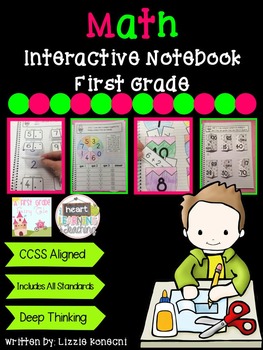Math Interactive Notebook made for First Grade
Elizabeth Konecni
983 Followers
Grade Levels
1st
Subjects
Resource Type
Standards
CCSS1.MD.A.1
CCSS1.MD.A.2
CCSS1.MD.B.3
CCSS1.MD.C.4
CCSS1.NBT.A.1
Formats Included
- PDF
Pages
101 pages
Elizabeth Konecni
983 Followers
Description
Do you ever wonder how we can take our math instruction to the next level? Interactive notebooking is an awesome way to build meaningful and hands-on instruction into your math block. Students can build their very own math interactive notebook that acts like a portfolio. Students apply their learning into the notebook as they put it together and play its game. It's an awesome tool for many reasons:
1. Students have access to all their learning from the year.
2. They can revisit standards to practice and build fluency daily.
3. It's a great portfolio to send home at the end of the year which shows parents all the learning that took place throughout the year.
4. It's fun for all!
This notebook is for a first grade classroom. It includes a notebook page for every standard in math. There are example pictures for each notebook page. You will also find an index for easy guidance.
1. Students have access to all their learning from the year.
2. They can revisit standards to practice and build fluency daily.
3. It's a great portfolio to send home at the end of the year which shows parents all the learning that took place throughout the year.
4. It's fun for all!
This notebook is for a first grade classroom. It includes a notebook page for every standard in math. There are example pictures for each notebook page. You will also find an index for easy guidance.
Total Pages
101 pages
Answer Key
N/A
Teaching Duration
N/A
Last updated Jan 3rd, 2015
Report this resource to TPT
Reported resources will be reviewed by our team. Report this resource to let us know if this resource violates TPT’s content guidelines.
Standards
to see state-specific standards (only available in the US).
CCSS1.MD.A.1
Order three objects by length; compare the lengths of two objects indirectly by using a third object.
CCSS1.MD.A.2
Express the length of an object as a whole number of length units, by laying multiple copies of a shorter object (the length unit) end to end; understand that the length measurement of an object is the number of same-size length units that span it with no gaps or overlaps.
CCSS1.MD.B.3
Tell and write time in hours and half-hours using analog and digital clocks.
CCSS1.MD.C.4
Organize, represent, and interpret data with up to three categories; ask and answer questions about the total number of data points, how many in each category, and how many more or less are in one category than in another.
CCSS1.NBT.A.1
Count to 120, starting at any number less than 120. In this range, read and write numerals and represent a number of objects with a written numeral.





